Closing the Gender Pay Gap in IT: A Step Closer to Clinking Champagne GlassesClosing the Gender Pay Gap in IT: A Step Closer to Clinking Champagne Glasses
However, the participation gap between males and females in the IT industry is still significant, according to ITPro Today's 2024 IT Salary Survey Report.

There is a notable shift in the landscape of gender parity within the IT industry, as highlighted by ITPro Today's 2024 IT Salary Survey Report. This year's data reveals a remarkable convergence in pay raises between male and female professionals. With just slightly fewer females than males reporting significant wage increases of 10% or more, the gap in salary hikes seems to be narrowing. However, beneath this encouraging trend, disparities persist, and significant challenges remain in achieving gender equity for IT pros.
Losing the Gap in Pay Increases
This year's ITPro Today IT Salary Survey Report, while still showing a disparity in salaries between females and males in the IT industry (Figure 1), reveals little difference in salary raises between them: 11.4% of females, compared with 12% of males, reported a significant wage increase of 10% or more. Eighteen percent of both females and males reported no wage increase (Figure 2).
.jpg?width=700&auto=webp&quality=80&disable=upscale)
Figure 1.
The widest division was found between those who reported a slight increase (1% to 4%) in their pay: 45% of females reported receiving a slight increase as opposed to 43% of males.
This was an improvement from last year's report, where the widest division between males and females was for a raise that "increased somewhat" (5% to 9%). Last year, 13% of females reported a raise that "increased somewhat," compared with 24% of males.
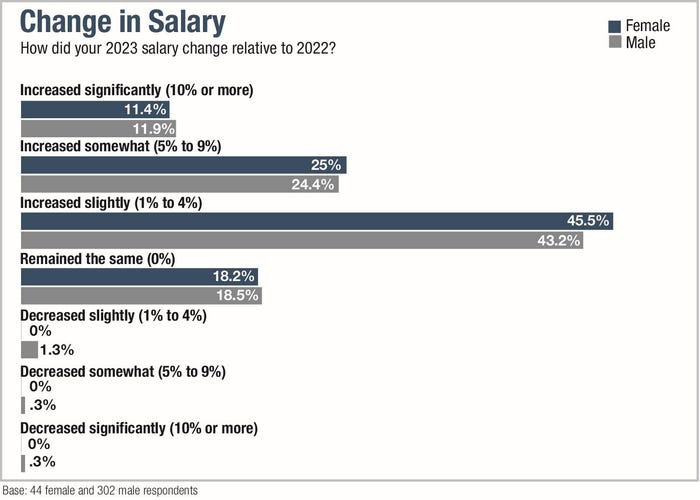
Figure 2.
In this year's survey, an even 25% of females and males reported raises of 5% to 9%.
All of this is good news for closing the gender pay gap. However, the good news gets murkier when we look at overall compensation pay, which is still slightly skewed toward males. Fifty percent of females reported that their wages were less than $125,000, compared with 48% of males who reported the same (Figure 3).
.jpg?width=700&auto=webp&quality=80&disable=upscale)
Figure 3.
However, there are multiple wage bands above $124,000 where females represented a larger share than males. For example, 9% of females reported wages of $175,000-$199,000 as opposed to 6% of males. Also, 11% of females reported wages of $200,000-$249,000 as opposed to 8% of males. Perhaps most surprising was the 5% of females reporting wages higher than $500,000 as opposed to just 1% of males reporting the same.
To make sense of it all, we consulted two experts for their insights.
"It would seem that the gender pay gap has been closed and superseded at all levels," said Dr. Bob Sarver in an email interview with IT Pro Today. Sarver is an associate professor of business at Waldorf University and a past senior director of supply chain management at Walmart with international experience in logistics and supply chain that included internet fulfillment. "However, it may reflect a push to bring women into the profession with higher salaries than normal."
In addition, Sarver noted, "If employers have strict salary bands that must be followed based upon level of skill and years of experience, this would also preclude them from even considering gender when assigning pay levels to employees."
If correct, then the IT industry would be a leader in the United States in closing the gender pay gap. Recently, Pew Research reported that the gender pay gap between men and women in general has largely remained the same for the last 20 years, from 80 cents women earned for every dollar a man earned in 2002 to 82 cents in 2022.
"No, it's too early to say the gap has closed," said Hansa Iyengar, senior principal analyst at Omdia, in an interview via email to ITPro Today. "While raise distribution is similar, overall compensation remains unequal … the persistence of [3%] more females than males in the lower wage bracket (<$124K) indicates that the pay gap has not been fully closed."
In regard to the upper end of the scale, Iyengar said: "The higher proportion of women in upper pay bands could be due to smaller sample sizes or self-selection bias — women who negotiate better pay being more likely to participate. The data does suggest a narrowing of the gender pay gap, especially at the upper echelons of salary bands."
Looking for Greener Pastures
While the survey results may be murky in interpreting the state of gender pay, one signal that IT work is getting more difficult for all is the response to the statement, "I can get my work done in a normal 40- to 45-hour workweek." Last year, 32% of females and 24% of males disagreed or strongly disagreed with that statement. This year, 39% of females and 27% of males disagreed (Figure 4).
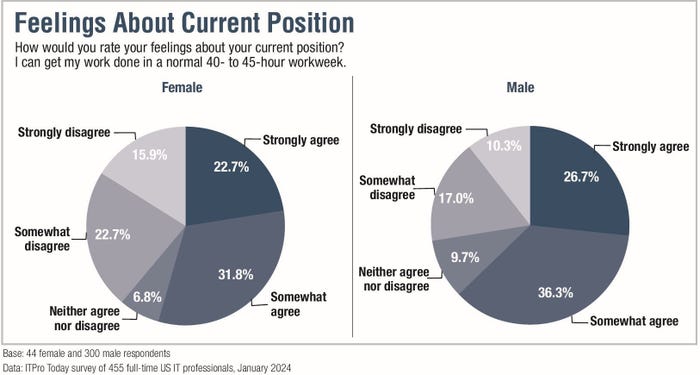
Figure 4.
Yet, the greatest difference between males and females in the salary survey this year compared with last year comes in responses to "How likely are you to leave the organization in the next 12 months?"
In last year's report, 32% of females and 27% of males reported being likely or very likely to leave their positions. However, this year, 25% of females and 38% of males reported to be likely or highly likely to leave their positions (Figure 5).
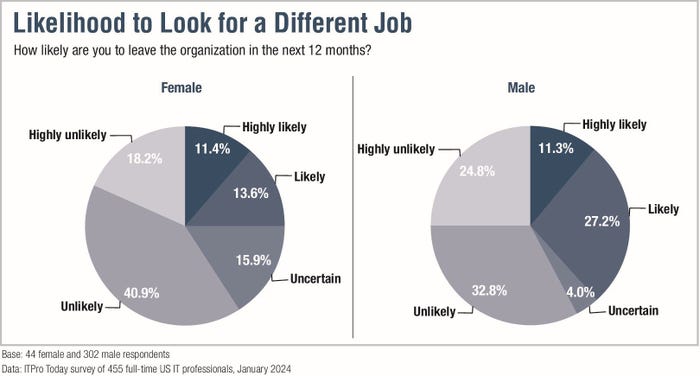
Figure 5.
Representing much of this change was 31% of males who last year reported that they were uncertain. In this year's survey, only 4% of males reported that they were uncertain. This change was not mirrored in females: Last year, 19% of females reported that they were uncertain, as opposed to 16% this year.
"Changes in the job market, such as increased opportunities elsewhere, shifts in job demands, or changes in organizational culture post-pandemic, might also be influencing these decisions," Iyengar said. The shifting IT job market is evident from the 191,000 layoffs in the sector in 2023. At the same time, research from Deloitte Insights reports that despite the layoffs, "90% of [tech] leaders said that recruiting and retaining talent were a moderate or major challenge," especially for senior technical roles such as those involving AI, suggesting that despite the layoffs, there are opportunities in the sector.
In addition, many of the return-to-office mandates could push IT employees, who are already burdened with burnout, over the edge from "uncertain" to an either/or decision. However, even though female uncertainty dropped, it wasn't at a similar level as their male colleagues. "Men are usually more 'adventurous' when it comes to changing roles," Iyengar said, "even at higher pay levels, while women might prefer the security of being in a high-paying role in an organization they are comfortable in, so psychological factors would also have an impact."
"There could be some age demographic dimensions when it comes to staying in position," Sarver said, "so it would be interesting to know how much of that was due to planned retirements, since men have been in this profession in much larger percentages for much longer than women."
According to the National Center for Women and Information Technology (NCWIT), women made up 27% of the IT workforce in 2023. Considering that nationally, women made up 47% of the civilian workforce in 2023 (compared with 30% in 1950), it makes sense to consider that in this year's report, 55- to 64-year-olds would largely skew male. That age group came in second in dissatisfaction with their compensation packages.
This age group is nearing traditional retirement age, and according to the Center for Retirement Research at Boston College, "2 in 5 of today's working households are in risk after retirement," according to their yearly National Retirement Risk Index (NRRI). This risk may be forcing males to consider greener pastures.

Alamy
There's Still Work to Be Done to Get to Champagne Toasts
ITPro Today's salary survey indicates that the IT industry has made great strides in closing the gender pay gap (Figure 6).
.jpg?width=700&auto=webp&quality=80&disable=upscale)
Figure 6.
However, it most definitely does not show a closing in the participation gap in the IT industry. NCWIT notes that only 27% of computing occupations are held by women, while our own survey's participation rate of females was only 13% (Figure 7). This is in stark contrast with Pew's report that 51% of the college-educated workforce in the U.S. is represented by women.
_(002).jpg?width=700&auto=webp&quality=80&disable=upscale)
Figure 7.
Speaking of college education, according to our survey, 79% of males have a bachelor's degree or higher, as opposed to 73% of females. Yet, 41% of females reported having a master's degree or MBA, compared with 32% of males, and 5% of females reported having a Ph.D. or other advanced degree as opposed to 4% of males (Figure 8).
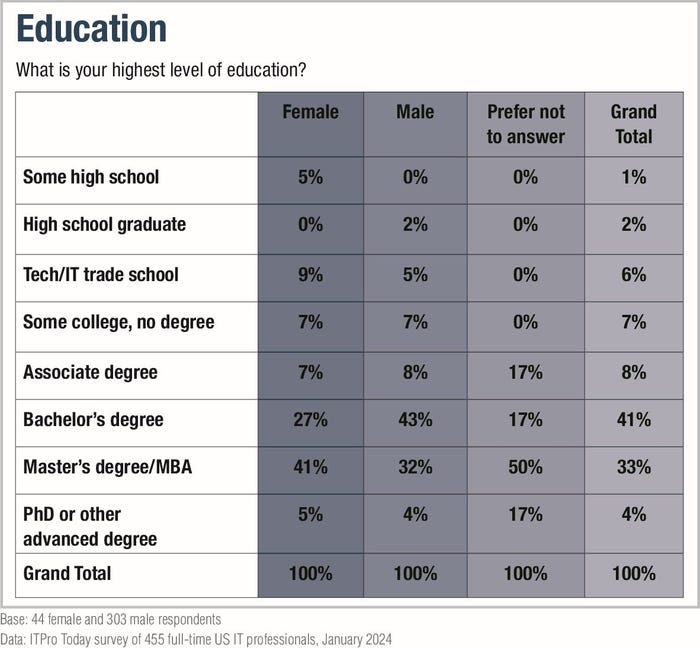
Figure 8.
Females face many obstacles (such as the "motherhood penalty") in the IT industry. As a result, 50% of women who take a tech role drop it by age 35, and there has been a decline in women graduating with a computer and information sciences bachelor's degree from 37% in 1985 to 23% in 2022.
This by no way means that women in IT don't enjoy working in the field. Although the percentage of females who are satisfied with and love their jobs might be lower than that of males, our survey found that a higher proportion of females are very satisfied with all aspects of their job (Figure 9) and strongly agree with the statement, "I love my job" (Figure 10), compared with their male counterparts.
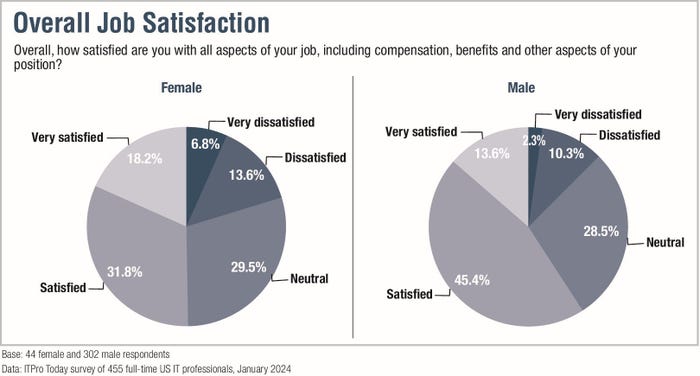
Figure 9.
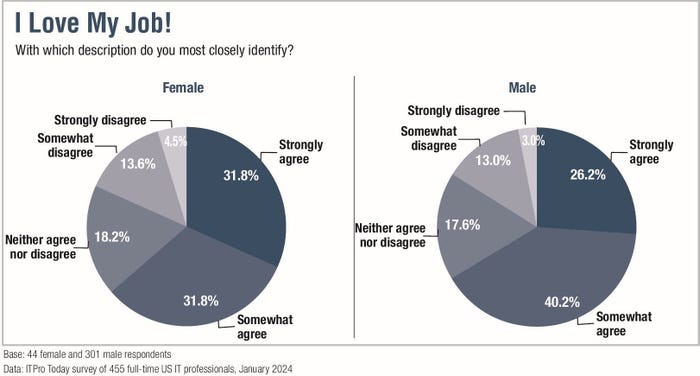
Figure 10.
There is a clear benefit to those companies that not only emphasize eliminating the gender pay gap but also closing the gender participation gap: higher stock prices. According to researchers from the Stanford Graduate School of Business, Tuck School of Business at Dartmouth College, Northwestern University, and the Hong Kong University of Science and Technology, share prices jumped when companies reported better-than-expected gender diversity, but they fell when firms announced demographics that underwhelmed. The reason? People believe that more gender-diverse companies are more innovative and less likely to get into regulatory trouble.
"People are not confused. They know the population of women is greater than 30%," Margaret A. Neale, a professor at Stanford who worked on the study, told Bloomberg back in 2019. "If Google moved up to 40%, there would be champagne toasts."
The Bureau of Labor Statistics expects the IT industry to grow by 15.2% by 2032. If it hopes to fill all those positions, the industry will have to continue closing the gender pay gap and the participation gap. And when it does, IT pros can raise their champagne glasses in a toast.
Read more about:
ITPro TodayAbout the Author
You May Also Like









